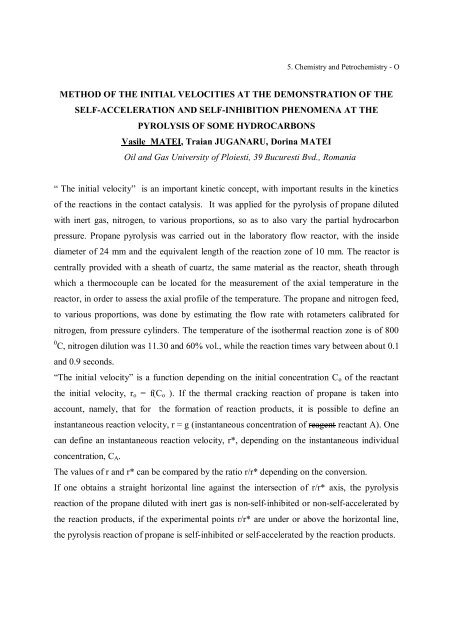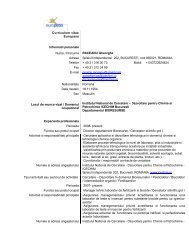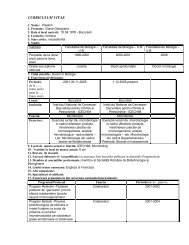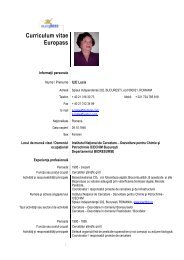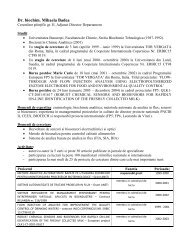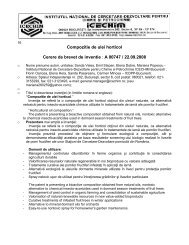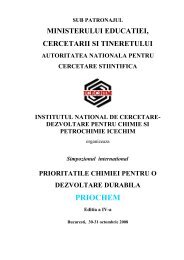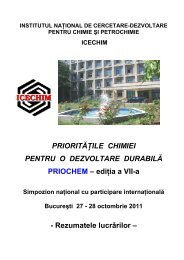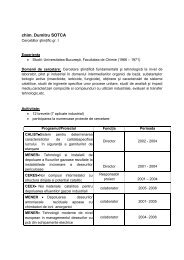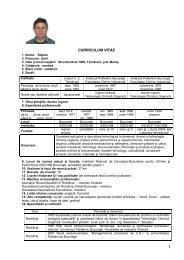INSTITUTUL NAÅ¢IONAL DE CERCETARE-DEZVOLTARE - ICECHIM
INSTITUTUL NAÅ¢IONAL DE CERCETARE-DEZVOLTARE - ICECHIM
INSTITUTUL NAÅ¢IONAL DE CERCETARE-DEZVOLTARE - ICECHIM
- No tags were found...
Create successful ePaper yourself
Turn your PDF publications into a flip-book with our unique Google optimized e-Paper software.
5. Chemistry and Petrochemistry - OMETHOD OF THE INITIAL VELOCITIES AT THE <strong>DE</strong>MONSTRATION OF THESELF-ACCELERATION AND SELF-INHIBITION PHENOMENA AT THEPYROLYSIS OF SOME HYDROCARBONSVasile MATEI, Traian JUGANARU, Dorina MATEIOil and Gas University of Ploiesti, 39 Bucuresti Bvd., Romania“ The initial velocity” is an important kinetic concept, with important results in the kineticsof the reactions in the contact catalysis. It was applied for the pyrolysis of propane dilutedwith inert gas, nitrogen, to various proportions, so as to also vary the partial hydrocarbonpressure. Propane pyrolysis was carried out in the laboratory flow reactor, with the insidediameter of 24 mm and the equivalent length of the reaction zone of 10 mm. The reactor iscentrally provided with a sheath of cuartz, the same material as the reactor, sheath throughwhich a thermocouple can be located for the measurement of the axial temperature in thereactor, in order to assess the axial profile of the temperature. The propane and nitrogen feed,to various proportions, was done by estimating the flow rate with rotameters calibrated fornitrogen, from pressure cylinders. The temperature of the isothermal reaction zone is of 8000 C, nitrogen dilution was 11.30 and 60% vol., while the reaction times vary between about 0.1and 0.9 seconds.“The initial velocity” is a function depending on the initial concentration C o of the reactantthe initial velocity, r o = f(C o ). If the thermal cracking reaction of propane is taken intoaccount, namely, that for the formation of reaction products, it is possible to define aninstantaneous reaction velocity, r = g (instantaneous concentration of reagent reactant A). Onecan define an instantaneous reaction velocity, r*, depending on the instantaneous individualconcentration, C A .The values of r and r* can be compared by the ratio r/r* depending on the conversion.If one obtains a straight horizontal line against the intersection of r/r* axis, the pyrolysisreaction of the propane diluted with inert gas is non-self-inhibited or non-self-accelerated bythe reaction products, if the experimental points r/r* are under or above the horizontal line,the pyrolysis reaction of propane is self-inhibited or self-accelerated by the reaction products.


